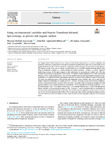Mostrar o rexistro simple do ítem
Using Environmental Variables and Fourier Transform Infrared Spectroscopy to Predict Soil Organic Carbon
| dc.contributor.author | Ghebleh Goydaragh, Maryam | |
| dc.contributor.author | Taghizadeh-Mehrjardi, Ruhollah | |
| dc.contributor.author | Jafarzadeh, Ali Asghar | |
| dc.contributor.author | Triantafilis, John | |
| dc.contributor.author | Lado, Marcos | |
| dc.date.accessioned | 2024-01-31T15:50:43Z | |
| dc.date.issued | 2021-03-19 | |
| dc.identifier.citation | Maryam Ghebleh Goydaragh, Ruhollah Taghizadeh-Mehrjardi, Ali Asghar Jafarzadeh, John Triantafilis, Marcos Lado, Using environmental variables and Fourier Transform Infrared Spectroscopy to predict soil organic carbon, CATENA, Volume 202, 2021, 105280, ISSN 0341-8162, https://doi.org/10.1016/j.catena.2021.105280. (https://www.sciencedirect.com/science/article/pii/S0341816221001399) | es_ES |
| dc.identifier.issn | 0341-8162 | |
| dc.identifier.uri | http://hdl.handle.net/2183/35286 | |
| dc.description.abstract | [Abstract] Soil Organic Carbon (SOC) content is a key element for soil fertility and productivity, nutrient availability and potentially represents a measurement of the sink for greenhouse gas abatement. Improving our knowledge on the spatial distribution of SOC is hence essential for sustainable nutrient management and carbon storage capacity. The objective of this study was to evaluate the performance of six tree-based machine-learning models when using environmental variables (i.e., remote sensing and terrain attributes - scenario 1), Fourier Transform Infrared Spectroscopy (FTIR) data (scenario 2) and combination of environmental variables and FTIR data (scenario 3) as predictors in prediction of SOC content. The models included Random Forest, Cubist, Conditional Inference Forest, Conditional Inference Trees, Extreme Gradient Boosting and Classification, Regression Trees. Furthermore, we explored if the Bat optimization algorithm can improve the prediction accuracy of the models. The study was conducted across a 7000 ha field in the Miandoab County, Northern Iran, with a total of 80 soil samples collected systematically in a regular grid (700 × 1000 m). According to Leave-One-Out Cross-Validation, the best prediction performance was achieved by the Cubist+Bat model when environmental variables and FTIR spectra (scenario 3) were used (Coefficient of determination = 0.73, Concordance Correlation Coefficient = 0.77, Root Mean Square Error = 0.36, Mean Absolute Error = 0.31, Median Absolute Error = 0.28). FTIR data had the highest influence on the prediction accuracy of SOC. Therefore, it can be concluded that the combination of environmental variables and FTIR data with Cubist+Bat model as a precise approach to monitor SOC in semi-arid soils of Iran. The final Digital Soil Map (DSM) of SOC revealed that improvements in prediction might be possible with the collection of more soil samples in areas where the land use and topography changed over short spatial scales. | es_ES |
| dc.description.sponsorship | This work is part of a PhD dissertation sponsored by the University of Tabriz (Tabriz, Iran). Part of the soil analysis, the FTIR spectroscopy and modelling were performed as a part of a stage at the University of A Coruna. All the help and assistance of the staff of the University of A Coruna is greatly appreciated | es_ES |
| dc.language.iso | eng | es_ES |
| dc.publisher | Elsevier | es_ES |
| dc.relation.uri | https://doi.org/10.1016/j.catena.2021.105280 | es_ES |
| dc.rights | © 2021 Elsevier B.V. All rights reserved. | es_ES |
| dc.subject | Aridisols | es_ES |
| dc.subject | Digital soil mapping | es_ES |
| dc.subject | Hybrid models | es_ES |
| dc.subject | Machine-learning | es_ES |
| dc.subject | Mid-IR spectral data | es_ES |
| dc.title | Using Environmental Variables and Fourier Transform Infrared Spectroscopy to Predict Soil Organic Carbon | es_ES |
| dc.type | info:eu-repo/semantics/article | es_ES |
| dc.rights.access | info:eu-repo/semantics/embargoedAccess | es_ES |
| dc.date.embargoEndDate | 9999-99-99 | es_ES |
| dc.date.embargoLift | 10007-06-07 | |
| UDC.journalTitle | CATENA | es_ES |
| UDC.issue | 202 (July 2021) | es_ES |
| UDC.startPage | 105280 | es_ES |
| dc.identifier.doi | 10.1016/j.catena.2021.105280 |






